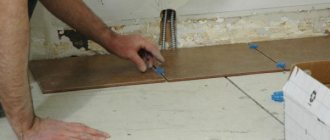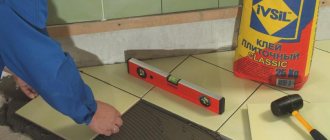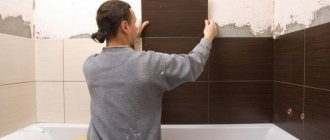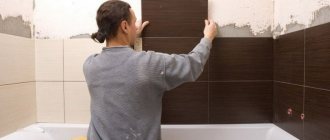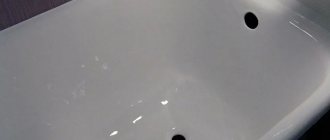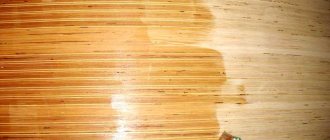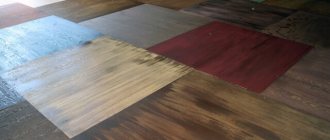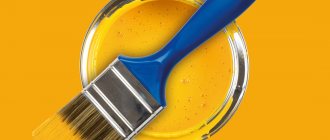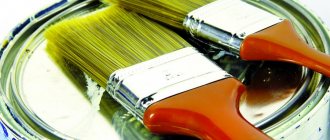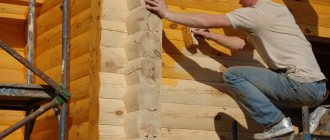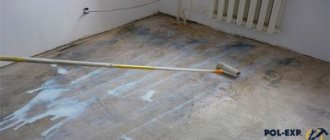The low cost of chipboard, high performance characteristics, and versatility of use have made them a very popular material. The most common areas of application are furniture production and construction. The main enemy of these slabs is water - the chips increase in volume, the slab swells, warps and crumbles.[contents]
Even at the very beginning of production, sawdust and shavings, after drying, are impregnated with formaldehyde resins. After pressing, the surface of the boards is laminated, sometimes even varnished.
But protecting the surface does not prevent the penetration of moisture from the ends through which it enters. Accumulating inside, water gradually begins to penetrate the wood fibers, which leads to the destruction of the slab. Consequently, the ends must first be saved from liquid penetration during operation. If they are tightly sealed, the service life of the slabs will be much longer.
The photo shows the effects of water on a chipboard countertop.
Why are the ends the starting point for destruction? Yes, because the production of slabs of the required standard sizes, as well as the preparation of pieces of material of different sizes, requires cutting. In this case, the integrity of the wood fibers is compromised.
Thus, chipboard protection from moisture is carried out in three directions:
- impregnation of wood fibers with resins;
- special surface treatment;
- end sealing.
Content
Even at the very beginning of production, sawdust and shavings, after drying, are impregnated with formaldehyde resins. After pressing, the surface of the boards is laminated, sometimes even varnished.
But protecting the surface does not prevent the penetration of moisture from the ends through which it enters. Accumulating inside, water gradually begins to penetrate the wood fibers, which leads to the destruction of the slab. Consequently, the ends must first be saved from liquid penetration during operation.
If they are tightly sealed, the service life of the slabs will be much longer.
The photo shows the effects of water on a chipboard countertop.
Why are the ends the starting point for destruction? Yes, because the production of slabs of the required standard sizes, as well as the preparation of pieces of material of different sizes, requires cutting. In this case, the integrity of the wood fibers is compromised.
Thus, chipboard protection from moisture is carried out in three directions:
- impregnation of wood fibers with resins;
- special surface treatment;
- end sealing.
What is a Countertop Edge?
The main task of the chipboard edge is to protect it from moisture. This is especially true in the kitchen and all ends of the kitchen countertop need to be covered. The edge also protects you from the release of formaldehyde from the chipboard (chipboard) countertop. As an alternative to edges, special end caps for tabletops are sold.
Interesting materials:
What are the earrings called? What are hoop earrings called? What are wide sweaters called? What are women's wide trousers called? What are pants with a low waist called? What are pants with elastic at the bottom called? What are the names of the states in Germany? What are lilac daisies called? What are the terms of multiplication called? What are the names of the modern territories of compact settlement of Indians in North America?
Surface treatment of plates
The front and back surfaces of the slab, as the largest contact areas, without any protection, can pass through and absorb, accordingly, the largest amount of liquid. It would be a good idea to cover these surfaces with something moisture-proof. Some of the methods of such coating are possible only in factory conditions, some are also possible at home.
One of the main methods of protection is lamination. In this case, a melamine film is laid on sanded chipboard at high pressure and high temperature. The essence of this process is not pressing, but the fact that under these conditions the film polymerizes the surface of the slab, becoming one with it.
There is another method that is performed in the factory - laminating. Pressure and heat are also used here, but more gentle. The already hardened film is pressed against the glue-coated slab. If lamination is a chemical process, then laminating is a mechanical process.
Components of laminated chipboard
At home, non-laminated chipboard is often coated with several layers of paint for protection. Before painting, pre-treat the surface:
- dust is carefully swept away and washed off the surface;
- for the first time, the plate is coated with hot drying oil;
- then this is done with cold drying oil until an outer crust forms;
- the top is painted. With any painting method, you must remember that each subsequent layer of paint is applied to the already dried previous one.
There are several other ways to protect yourself from getting wet. For example, a surface that will not be subject to mechanical stress can be protected as follows: rub it with stearin, then heat it with a hairdryer. Let cool and repeat this a couple more times. Or: one part of bitumen varnish is mixed with five parts of drying oil. Coating is carried out twice.
Drying installation
To avoid water droplets getting on the chipboard in a drying cabinet, when purchasing the latter, you need to pay attention to whether a special tray is attached to it. If this is not observed, then it is better to refuse to purchase such drying, since water draining from the plates and falling to the bottom of the cabinet will inevitably cause its damage. In addition, good ventilation is necessary here. This can be achieved either by installing “holey” facades, or by making a small through hole at the top of the cabinet, which can be given a noble appearance using a socket for wires (these are often used in the manufacture of computer desks).
How to treat plywood, chipboard and wood to protect against moisture?
The most susceptible to moisture are the sink, cabinet with dryer, countertop, and furniture near and above the stove.
The taps all start to leak at some point. So, the most potentially dangerous place in the sink is where the faucet crashes into the countertop. This is the point of contact between metal and wood. It is possible not only for the faucet to leak, but also for water to condense at the contact point. Therefore, this place is cleaned and dried with a hairdryer. Next, a layer of PVA glue is applied, after which it dries - silicone. You can use construction sealant, this is also a silicone mass; it even seals window frames against leaks.
The edge not only protects the chipboard from moisture, but also reduces emissions of harmful substances
In the dish cabinet, you should check the presence or absence of a tray: if it is not there, the liquid, flowing to the bottom of the cabinet, will ruin it. For all kitchen furniture where it is possible to get wet, you need to make it a rule: degrease this area and then do not skimp on the sealant.
To seal the seams, it is better to use sanitary silicone of a suitable shade: dark mold spots will not appear on the surface.
Non-laminated edges of the tabletop are covered with connecting or end strips. They come in metal or plastic. The protection is not so great, so the end of the tabletop should first be treated with silicone. Another method of protection is to apply furniture varnish or PVA glue to the cut area. Self-adhesive films or tape offered by the construction market cannot be called reliable protection.
Laminated models and their repair
Laminated surfaces, despite their durability, also wear out. If the tabletop is swollen, you can fix it in the following way:
- heat the deformed area with a hairdryer;
- remove the damaged piece;
- treat the damaged area with glue;
- pour the prepared mixture of sawdust and PVA into the damaged area;
- compact the mixture with a spatula;
- the surface should dry within 24 hours.
If the surface is not only damaged, but also swollen, a number of actions should be taken to restore the shape of the slab.
Sealing chipboard joints on the floor
The difficulty lies in the fact that the slabs on the floor are constantly subjected to significant physical stress; they “play” relative to each other. For this reason, the putty does not want to stick. There are several popular ways to seal such seams.
The seams are covered with epoxy mixed with sawdust. The sawdust is first finely sifted. The composition sets very quickly, so it is not worth preparing a large volume of such putty at once. Such protection serves for a long time and reliably. But the price of epoxy is high, and sealing joints is expensive.
You can replace the epoxy with hot wood glue. You need to mix sawdust in it and go through the seams.
The effect is achieved even greater than with epoxy, since the hot glue penetrates deep inside. This method also saves from moisture, and the joint stops “playing”. True, it is advisable not to walk on such a floor for several days, since wood glue takes a long time to dry.
This method is much cheaper. And if the floor is covered with linoleum on top, then you can completely forget about damage to the chipboards.
You might be interested to know
How to make a seamless wide tabletop with plastic coating with your own hands
During the holidays, mothers and grandmothers have to spend all day in the kitchen. Things go faster if everything is at hand. And everything is at hand when the cutting table, stove and sink are conveniently located and united by a wide, solid tabletop.
Today we have heard a lot about “kitchen islands” covered with marble or granite slabs. At furniture exhibitions and at friends’ houses, we touched countertops made of artificial cast stone and saw mosaic cladding. Everyone knows laminated chipboard countertops with their undeniable advantages. But there is a more interesting idea. A solid tabletop can be constructed from non-laminated chipboard or MDF and covered with sheet decorative plastic. It's not as difficult as it seems. It's worth trying to get the perfect exclusive.
How can you protect chipboard panels from moisture?
1. Treating chipboard with drying oil
One of the simplest methods is applying drying oil to a chipboard. Most often, this method is used when the particle board is planned to be laid on the floor when creating a rough screed. Drying oil is applied to the main part of the slabs in two layers. Drying oil should be applied to the ends of chipboard boards at least three times, since in these areas it will be absorbed especially intensively.
To increase the moisture resistance of chipboard panels, you can add a little bitumen varnish to the drying oil. 1 part varnish to 5 parts drying oil is enough.
2. Painting chipboards with PVA glue
It will be possible to increase the waterproof performance of the particle board if you coat it with PVA glue. This method is used in almost any situation. That is, a slab treated in this way can be used to level surfaces and install partitions. But you can start work only after the glue has completely dried.
Chipboard impregnation - odor protection
Pasting chipboard with protective film
Another successful way to protect chipboard from moisture is to stick a special protective film. It not only protects the material from contact with moisture, but additionally improves its appearance. That is, the self-adhesive film also performs a decorative function. The owner just has to choose a suitable sample and stick it correctly. To do this, the panel should be cleaned of dirt and dust, the protective layer should be removed from the film and it should be glued. Special decorative corners with water-resistant qualities are installed at the ends.
Each method has its own advantages. And the owner who manages to do the job correctly will receive chipboard panels that are reliably protected from moisture. Then the finished material can be used for work even in those premises that do not have the most favorable operating conditions.
You can treat the countertop, or rather drink it under the hob, and wash it using metal tape. The effect is simply classy, the countertop will probably age faster.
Nitrocellulose varnish
There is another way to protect chipboard from moisture - nitrocellulose varnish. Its protective effect is similar to polyurethane varnish: it forms a kind of protective coating on the surface of the product, preventing the penetration of moisture, while resistance to damage is equivalent to the maximum value. A significant advantage of nitrocellulose varnish over its predecessor is the application of the substance without prior preparation of the workplace, but to achieve better results we strongly recommend priming the chipboard.
To significantly protect chipboard products, you need to use a combined protection method. It is best if it not only consists of an impregnation stage with deep penetration of the substance, but also includes the application of additional paints and varnishes.
Chipboard is an excellent construction material, but is not very attractive in comparison with wood, and is also particularly susceptible to environmental factors. Products made from chipboard receive certain protection during the manufacturing process. For this, all kinds of impregnations and additives are used. However, under intensive operating conditions, such factory measures are not enough, so it is recommended to further protect the material. How to protect chipboard, as well as treat it with finishing materials, will be discussed below.
How to protect the legs of laminated chipboard cabinets from moisture?
BUT as always there is a BUT. The material is easily vulnerable, and quite (carefully and carefully) labor-intensive, maybe that’s why we don’t particularly like it among assemblers, or maybe someone doesn’t know. As they say, the eyes fear, but the hands do.
PS the base of the tape is aluminum foil.
———————————————————————————— Drying oils are film-forming paints and varnishes based on processed vegetable oils. The composition of natural drying oils includes exclusively drying vegetable oils (linseed, hemp, sometimes sunflower oil is added) and driers. Drying agents are manganese, cobalt, and lead salts of carboxylic acids that accelerate the drying process. Organic solvents are added to the composition of semi-natural drying oils - white spirit, ski*****, Solovent oil. Oxidized drying oils are obtained by heating linseed or hemp oil to 150-160 degrees, stirring and passing drying agents through them. Such drying oils have greater viscosity, increased durability, shine, and a darker color than natural ones. Compacted drying oils, unlike natural ones, are obtained through longer heat treatment at a temperature of about 300 degrees.
Fungus appears on silicone coatings over time.
Dear visitor! You are in the archive of the old forum on mastergrad.com
How to protect chipboard from water?
| Paul 21 July 2004 16:35:58 | Good afternoon a problem arose - the chipboard frame of the kitchen swelled from leaking. The edges were laminated, but this did not help - I think the technology was broken, or the chipboard was bad. The kitchen manufacturer changed the frame, but to avoid the problem I want to pre-treat the edges. Question - with what? Yesterday I tried to cover it up I used liquid nails to cut the chipboard and place the treated end in a bowl of water - it swelled overnight...:(((Advise which product is best to use for sealing the edges? Good luck Pavel |
| Shadow (Moscow) July 21, 2004 18:06:44 | 2 Paul: Rub the exposed areas with silicone sealant. |
| Shadow (Moscow) July 21, 2004 18:10:32 | 2 Paul: Sorry - by open areas we mean non-laminated areas of the frame. In addition, nothing prevents you from applying that sealant to the laminated edges - the silicone film certainly will not allow water to pass through. |
| Paul 21 July 2004 20:10:49 | 2Shandow: I rubbed silicone sealant on the chipboard countertops (cutout under the sink) - it didn’t hold up well :((. I think it will be even worse on a laminated surface... Here you need something penetrating - I’ll try parquet varnish. I’ll let you know about the results. Good luck Pavel |
| Serg (Samara, Russia) July 22, 2004 01:31:38 | 2Paul: |
Soak with drying oil several times.
Best regards, Sergei
You can apply it heated in a water bath - it will be better absorbed.
Best regards, Sergei
How can you coat chipboard to make it waterproof?
If such a tool existed, then manufacturers of chipboard kitchens would already be using it :). IMHO, there is no point in looking for a good solution. Only impregnate with drying oil and do not fill with water :).
Applying drying oil heated in a water bath is a standard technique.
> Chipboard is poorly saturated.
From the cut side, the slab is impregnated quite well.
There is a way to do this: immediately mark all the technological holes and then stick the melamine on the back wall too.
The front, rolled up end raises no questions for anyone - so you need to do the same with the rear.
Chipboard is one of the most affordable building materials, so many are interested in the question: how to impregnate this material from moisture? And, if in the summer there is a low probability of moisture getting on the floor, then in the winter it forms in any case. In this article we will give practical advice on how and with what to soak chipboard from moisture?
Selection of furniture based on material of manufacture
Start choosing furniture for your bathroom by studying the materials available. The service life and comfort of using the headset depend on the correctly selected material. In addition to convenience and visual appeal, the material must withstand high humidity and be easy to clean. The most common furniture is made from the following materials:
- Chipboard and MDF boards
. The material is derived from wood and is widely used due to the choice of colors and optimal price-quality ratio. Cabinets and bathroom cabinets with rectangular corners are made from chipboard; MDF material is used for concave and convex shapes.
- Natural wood. The material is loved by customers for its environmental friendliness and luxurious appearance. However, even with the use of special wood impregnations, the material does not tolerate high humidity. The cost of furniture made of wood is high, and that makes it even more offensive if the cabinet quickly breaks down or loses its presentable appearance.
- Plastic. Plastic furniture is affordable, it is not afraid of moisture and dampness. The most fastidious buyers will find solutions for themselves in the huge variety of shapes, textures and colors offered by manufacturers of plastic furniture. The disadvantages of plastic furniture include fragility, the facades are fragile, the furniture can crack from an impact, and over time scratches and chips will appear.
- Metal. Metal furniture, if properly processed, has a long service life. It will decorate a modern minimalist style or the currently popular hi-tech style, but will not fit into a classic and home interior.
- Glass. Glass furniture is a new trend in interior design. Made from tempered glass, has no sharp corners, and comes in transparent or translucent form. Cleaning such furniture, although not difficult, requires regularity. There are risks of breaking, which can be reduced by choosing furniture made of plexiglass. Another nuance is the aesthetic perception of transparent boxes, the contents of which most often want to be hidden from prying eyes.
